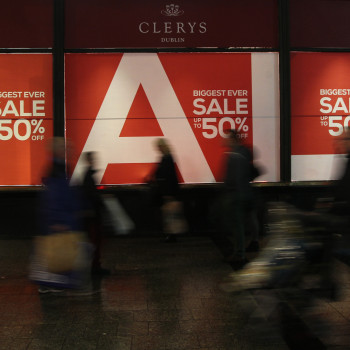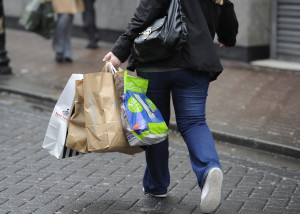Time to get used to the new normal

With renewed talk of economic recovery and a return in consumer confidence, Dan White quickly pours cold water over this premature optimism by pointing out that consumers are still under financial pressure, rents are still too high and competition from the internet is eating away at the traditional retailer’s market
11 February 2015
Retail sales may have bottomed out but with consumer confidence remaining fragile, retailers are still cutting prices to keep shoppers coming through the door. With the exception of construction, no sector of the Irish economy suffered more during the downturn than retailing. The value of retail sales fell by a quarter from its 2007 peak and an estimated 50,000 shop workers lost their jobs. A slew of big name retailers including Superquinn, Xtra-vision, Homebase, B&Q, Atlantic, O’Brien’s Sandwiches and A-Wear, were either forced to seek protection from their creditors or disappeared completely.
The good news is that the great post-Celtic Tiger retail bust finally seems to have come to an end in 2014. The latest CSO figures show that the value of retail sales was 2.3% higher in December 2014 than in December 2013 while the value of full-year retail sales was 4.1% higher in 2014 than it was in 2013.
So far so good. Unfortunately when one examines the CSO retail sales data more closely it quickly becomes apparent that there is less to the “recovery” than meets the eye. The CSO’s retail sales index is severely distorted by motor sales, which are extremely volatile. This was particularly true last year as new car sales jumped by almost 30%.
Cutting prices to get shoppers in the door
Strip out motor sales and a far less rosy picture quickly emerges. The value of non-motor sales rose by just 1.7% in December and by 1.6% for the year as a whole. And that’s only half of the story. The volume of retail sales rose by 4.8% in December and by 3.7% for the whole of 2014. In other words, retailers had to cut their prices by somewhere between 2% and 3% to get shoppers spending again.
This is reflected in the CSO inflation data with several categories of goods experiencing further sharp price falls in 2014. These include clothing and footwear (down 3.3%), furniture and household equipment (down 2.9%) and food (down 2.3%). These deflationary trends are likely to continue into 2015. While a collapse in oil prices would normally be good economic news, these are not normal times. Throw in the fact that Chinese factory gate prices fell by 3.3% in 2014 and it is clear that further price cuts will be required in 2015 to keep the tills humming.
Deflationary trap
Deflation or falling prices can wreak economic havoc. Why buy something today if you can get it for less tomorrow? If Ireland and the rest of the Eurozone were to get trapped in a deflationary trap it could take us decades to escape, as the Japanese example has demonstrated. Indeed deflation has already taken a hold with average Eurozone prices falling by 0.6% in the year to January 2015 while Irish prices fell by 0.3% during calendar 2014.
Despite this uncertainty consumer confidence has been steadily improving, with the KBC Bank/ESRI index of consumer confidence hitting a nine-year high in January 2015. However, while consumer confidence has been gradually recovering along with the economy and the jobs market, it remains extremely fragile with sharp one-month falls being recorded in both May and October. Could a sudden economic shock, such as a spike in oil prices or a disorderly Greek exit from the Eurozone, trigger similar falls in 2015?
Consumers remain jittery
 It’s not difficult to see why consumers remain jittery. Despite the recovery in the labour market, with the unemployment rate falling from over 15% in 2012 to 10.5% in January 2015, workers’ pay packets have yet to benefit. Average public sector weekly earnings fell by 0.9% and those in the private sector fell by 0.4% in the year to the third quarter of 2014. Mortgage arrears and negative equity are also acting as a drag on consumer sentiment with the latest Central Bank figures showing that 156,000 mortgages, over a sixth of the total, were still in arrears at the end of September 2014.
It’s not difficult to see why consumers remain jittery. Despite the recovery in the labour market, with the unemployment rate falling from over 15% in 2012 to 10.5% in January 2015, workers’ pay packets have yet to benefit. Average public sector weekly earnings fell by 0.9% and those in the private sector fell by 0.4% in the year to the third quarter of 2014. Mortgage arrears and negative equity are also acting as a drag on consumer sentiment with the latest Central Bank figures showing that 156,000 mortgages, over a sixth of the total, were still in arrears at the end of September 2014.
So where do retailers go from here? Was 2014 the start of a sustained recovery which will eventually lift all retail boats or did last year merely flatter to deceive?
When considering the Irish retail sector, the first thing to bear in mind is that, even after last year’s increase, the value of non-motor sales is still more than 20% down on its 2007 peak. Anyone expecting a quick return to the “good old days” is likely to be disappointed.
Upward only rents have not gone away
Not alone is the value of retail sales still well down on peak levels, many retailers remain hamstrung by upward-only leases from the Celtic Tiger era. Things have been further complicated by the fact that many retailers have been able to use the examinership system to repudiate upward-only leases. Retailers who have been able to walk away from upward-only leases are now operating at a huge competitive disadvantage to those that have.
Any hope of relief that these retailers might have entertained were dashed by the 2014 Supreme Court ruling in the Bewley’s case. In 2013 the High Court decided that the iconic Grafton Street café should only pay its landlords the market rent. This decision was overturned a year later by the Supreme Court, which in its wisdom ruled that Bewley’s was legally obliged to continue paying an annual rent of €1.46m – twice the market rate. That’s a heck of a lot of sticky buns!
Online competition
And then there is the little matter of the internet. How much of the fall in the value of retail sales since 2007 was due to the economic downturn and how much of it was caused by the migration of sales online? Unfortunately no accurate figures exist for online sales but a 2013 survey by IBEC estimated the figure at over €4bn. While some of this has been captured by Irish retailers’ own websites a large part of it has migrated, probably never to return, to specialist online retailers such as Amazon.
All of which means that Irish retailers are now confronted by a “new normal”, where prices will keep falling, consumer confidence remains fragile and competition from the internet and the discounters will intensify.



 Print
Print


Fans 0
Followers